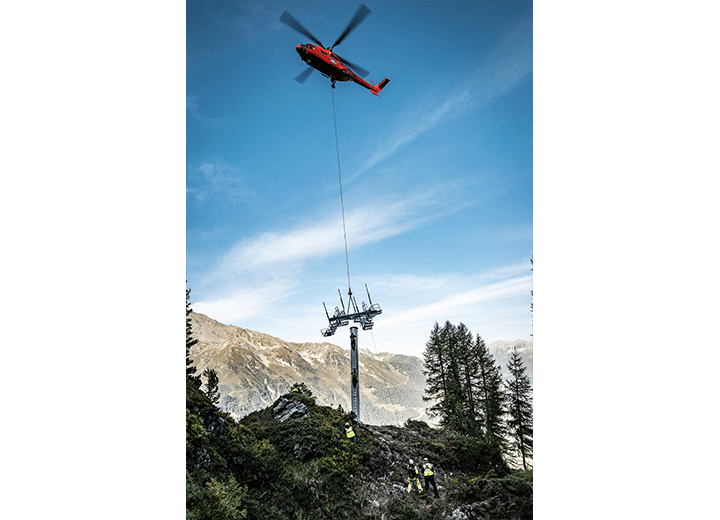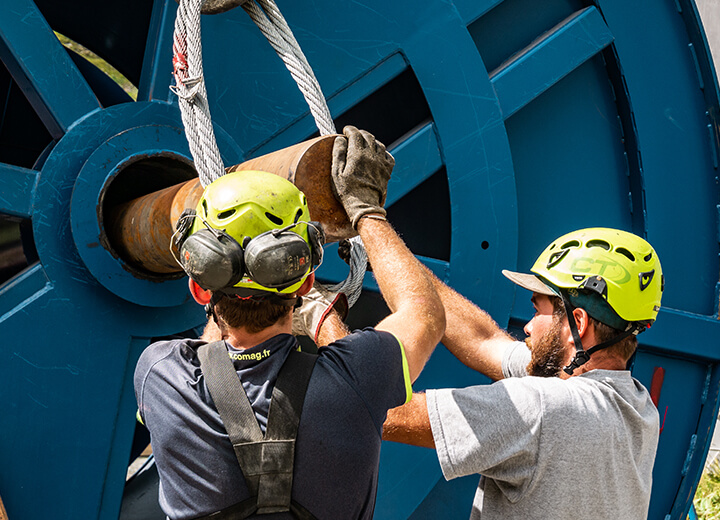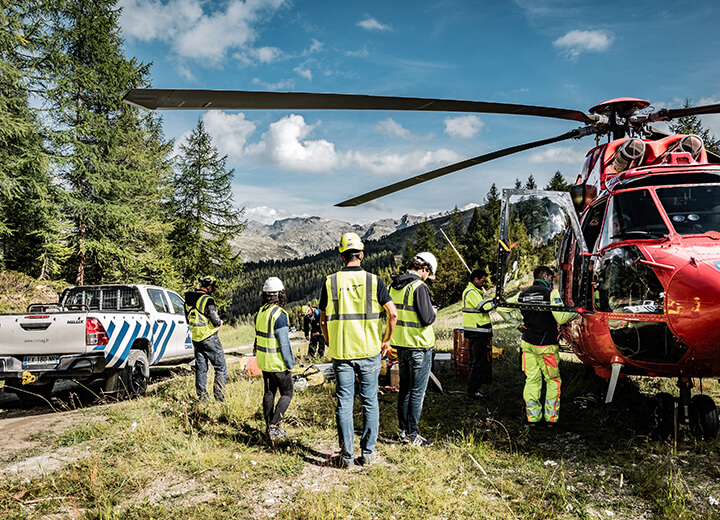
Construction & Installation

POMA’s core business
POMA travels around the world to set up ropeway transport systems and works to adapt to the demands of each customer, from the supervision of local workers to turnkey assembly.
The teams of the POMA Group have a Work and Assembly Expertise service, which includes experts from the COMAG and SEMER subsidiaries as well as SIGMA. They work on the construction of new systems and perform maintenance operations efficiently, reliably and quickly, in all parts of the world.
Why POMA ?
Dedicated teams of experts
Each year, the group's staff are trained or retrained: new techniques, standards, safety regulations, and so on. All the skills required for assembly operations are validated. Moreover, there is real cohesion between teams within the group, based on shared human values. At the heart of our concerns, this essential element undoubtedly contributes to the success of our projects.
Quality equipment
High-quality equipment and precision tooling are essential in order to guarantee good conditions in which to carry out operations. The POMA Group invests every year to provide its teams with the best technical equipment and tools. For its entire stock, POMA guarantees safe, high-quality equipment that is perfectly suited to its purpose.
State-of-the-art assembly method
The more widespread use of station pre-assembly operations improves the quality of the work and limits the environmental impact. This eco-friendly method allows us to achieve genuine feats, such as one of the first major operations carried out by our teams: the installation of four stations in four days in Avoriaz (France) in 2014.
New techniques of ready-mixed concrete and prefabricated formwork reduce the time required to install the structures. These innovations implemented by POMA make a real difference to new ropeway installation projects because they provide optimal work conditions, reducing the time required for operations and on-site presence, while reinforcing the safety of teams and everyone involved.
Addressing environmental issues
Eco-friendly construction sites is an approach that POMA has adopted in order to limit the environmental impact of the installation, in both natural and urban environments. The study of assembly methods goes hand in hand with environmental concerns, in line with our vision of the profession.
The infrastructure of the system and the line structures must be harmoniously incorporated into the landscape. This non-negotiable for POMA. It is with the same respect that we take into consideration the plant and animal eco-system, regularly consulting ecologists to ensure that a construction site does not disturb the life of protected species.
In Toulouse, for example, on the TELEO urban ropeway, the ropes were drawn at a specific time of year so as not to disturb the life cycle of the species living on the banks of the Garonne river, such as the endemic kites. Similarly, a bird protection system was put in place for the comfort of bats circulating in the area.
Exceptional know-how for international operations
Throughout a project, POMA has full control over the value chain. Our teams are experts in the installation and maintenance of ropeway transport systems, and have been working on construction projects since 1936, in France and worldwide.
The different stages involved in the assembly of a ropeway transport system
1. Structural and civil engineering, operations within a fixed time-frame
The structural and civil engineering part—known as “functional work”—of POMA ropeway transport installations are works of art in reinforced concrete. These are the concrete foundations on which the station structures, the different buildings and the rope line structures (towers) will be built.
The use of machinery to perform civil engineering work has gradually enabled us to optimise assembly times. Helicopter transport, unwinding of ropes using drones, and the use of specific equipment such as walking excavators and huge aerial cranes, which can operate on very steep terrain… all of these techniques have been developed in partnership with specialised companies and have saved valuable time and enabled assembly operations to be carried out in the most inaccessible parts of the world.
2. transport et logistics
The mechanical components and sub-assemblies (drive groups, roller batteries, cabins, chairs, etc.) manufactured in our workshops are delivered to the site. The number of transloading operations is kept to a minimum, with the aim of ensuring energy efficiency.
On installations for export, parts are generally transported in shipping containers from the group’s logistics platform: the Gilly-sur-Isère site.
3. Mechanical assembly of the station and line, and electrical connection
The longest part of the construction project involves assembly of the line structures and construction of the stations.
The towers are made up of several sections of metal tubes, yoke assemblies and roller batteries. Depending on the project, the towers are assembled via impressive helicopter operations that require a high level of precision, or using cranes.
The stations are made up of modules already pre-assembled in the workshop to speed up and facilitate on-site assembly. First the mechanical components such as the brakes, drive group, new DirectDrive® technology, sheave, hydraulic cylinder, tensioning frame, etc. are installed, then the station turnaround and roof are assembled on the station, and finally, the electrical connections for the safety devices are carried out by the SEMER teams.
POMA and its teams from COMAG, SEMER and SIGMA are committed to finding the best assembly solution for the specific needs of the construction site and its allocated construction time. Pre-assembly and pre-connection of station components and different types of carriers are a prerequisite for reducing the time spent and the environmental impact on site, as well as for the safety of teams.
4. Rope installation, unwinding and tensioning
Once the stations and towers have been built, the teams start installing the rope, in other words, producing the rope loop on which carriers, stations, chairs or buckets for the transportation of materials will travel. The rope is installed in four steps:
- A 15 mm-diameter steel wire (called “open cord”) is installed by helicopter, drone or by hand on the line and in the stations. Construction drones are increasingly being used in urban areas, to facilitate the unwinding of the rope between buildings and to avoid encroaching on private land and homes.
- Drawing of the final rope. The final rope is attached to the end of the wire and is pulled using a powerful winch operated by a hydraulic motor. The rope goes around the sheave.
- Once the rope has been drawn, the two ends are placed in parallel to make the splice. To find out more about this 100% manual operation, which requires a very high level of technicality and control, please read our detailed article on how the splice is produced
- When the splice is finished, the rope is placed on the towers and tensioned.
The rope installation is almost certainly the most specific and difficult part of the construction of a ropeway transport system. POMA has the full set of technical skills required, having managed to improve long-standing processes to adapt to ever more ambitious projects. Our teams are able to put their expertise into practice in large-scale operations throughout the world, carrying out both rope unwinding and replacement operations. Using state-of-the-art tools.
5. Assembly of the carriers
The carriers are attached with grips and suspended on the rope, or put into the garage.
6. Setting up and testing
When the assembly is complete, the mechanical settings and electrical calibration are carried out by SEMER’s specialised technicians. They connect the electrical control and command system to the electric motor and all other safety devices in the stations and towers.
Finally, before the system goes into operation, many functional tests and inspections are carried out ahead of a final technical inspection in the presence of the inspection authorities, who check that the system complies with specific legal and national requirements.
DISCOVER OUR OTHER EXPERTISE

Technology
From mountains to cities, transporting tourists and materials, POMA is known worldwide for its skill in designing, making, operating and maintaining ropeway transport solutions. For decades, POMA’s technologies have been honouring the commitment to provide a comfortable, fast, energy-efficient, silent and non-polluting form of transport.
Learn more
Industrial assets
The lifetime of our products, up to 50 years, requires total quality control. A commitment that reflects POMA’s industrial choices over its value chain, notably through production facilities that are optimised in terms of both infrastructure and process.
Learn more




























